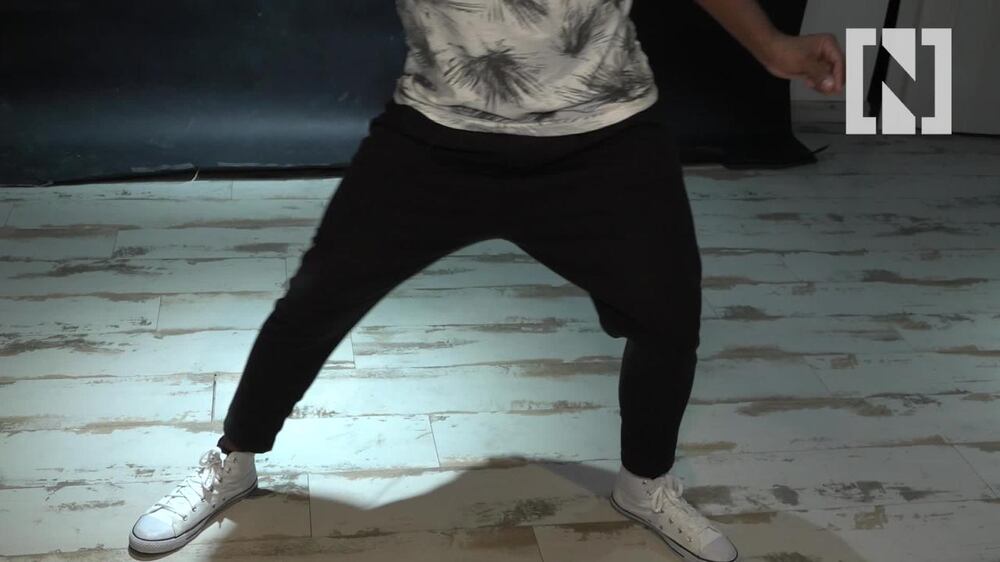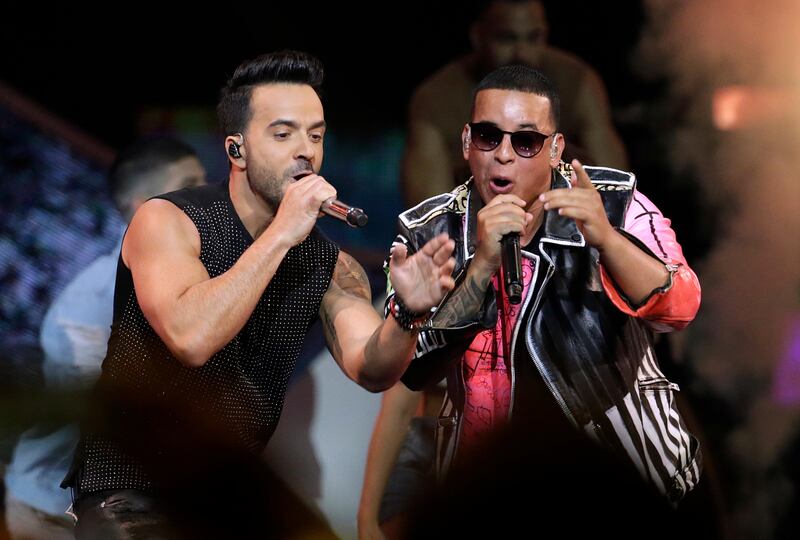When Luis Fonsi began composing Despacito in 2015 the creative well was almost dry. The Puerto-Rican singer had not released any new material for two years and was itching to get back into the charts.
Then came Despacito. The song that has become this year's most popular to date, was sketched in various forms including as a cumbia and a standard pop offering.
Intrigued by the chorus’s urban appeal, Fonsi decided more attitude was needed, so he asked reggaeton stalwart Daddy Yankee to get involved. Colombian producers Mauricio Rengifo and Andrés Torres then put their touches to the song, and when the duo heard the new, improved version of the track, it was ready to storm the charts.
"Both Daddy Yankee and I were surprised that it sounded powerful, fresh and different," Fonsi told Billboard in March, two months after the song's release. "But at the end of the day no one knows, it's simply the fans who decide whether a song is successful or not."
The response Despacito got was phenomenal.
Two weeks from its eight-month anniversary, Fonsi's comeback track has broken the global streaming record previously held by Justin Bieber's Sorry, at more than 4.6 billion plays across a variety of online platforms.
To date it has topped 50 international charts including the United States, the United Kingdom and those in South American markets such as Brazil and Argentina. Its popularity caused a ruckus in Malaysia, with the government banning it from the airwaves because of its perceived racy lyrical content.
And while it has reestablished Fonsi as a force in the Latin pop scene, Despacito has in the process elevated reggaeton from a genre played in the slums in Panama and Puerto Rico to a dominant force in popular music.
American ethnomusicologist Wayne Marshall at Berklee College of Music is watching the reggaeton phenomenon with interest.
As editor of 2009's Reggaeton – a collection of cultural essays exploring the artistic and socio-economic currents that make up the art form – Marshall says the genre's current popularity is more than a passing fad.
“I would consider it more a resurgence,” he says, from his base in Boston.
“Reggaeton’s run of popularity started a decade ago, built on several crossover hits by Puerto Rican artists, and this sets a good
precedent for this return to prominence of reggaeton style.”
Like most modern genres, reggaeton was born out of a fusion of existing musical flavours. Initially known as Reggae en Espanol (Spanish Reggae) in the 1970s, when Jamaican popular music spread to South America, musicians used it as their base to add whatever style was current at the time.
The Latin reggae vibe made way for dancehall, which took the world by storm in the late ’80s, followed by hip-hop a decade later.
It was the latter that allowed reggaeton to take hold in South American communities in the US, with underground clubs and cassettes featuring the latest music or “riddims”.
The term "reggaeton" was coined by US-based Puerto Rican DJ Nelson in 1995. The eventual crossover arrived in 2004, with Puerto Rican artists such as Daddy Yankee (Gasolina), Don Omar (Dale Don Dale) and Colombian star Shakira (La Tortura – Shaketon Remix) all releasing singles that dented the pop charts.
More than the fiesta vibe and saucy lyrics, Marshall is of the opinion that reggaeton’s ear-pulling appeal lies in its signature beat, dubbed as the “dembow”, and a vocal style which pays tribute to its Caribbean roots.
"It is a beat derived from dancehall reggae," he says. "The palette can be quite varied, though synthesizers predominate. And, of course, Spanish-language sing-song rap, also deeply indebted to the vocalising in Jamaican dancehall. Without vocals, a reggaeton track and a dancehall track might be tricky to distinguish."
The different variations of these beats have been used to great chart-topping effect by popular artists over the years, including last year's hits from Rihanna (Work) and Drake (One Dance).
Marshall says all this points to the fact that popular music is drawing more of its inspiration from Africa and across the Caribbean.
“It’s that same Afro-Caribbean rhythm that underpins reggaeton,” he says, mentioning the recent success of Drizzy and RiRi.
“The rise of these Afro-Diasporic polyrhythms over the last 10 to 15 years across the global pop and dance landscape is the bigger story here. Reggaeton is playing the role of one crucial vector for that spread.”
Also paying close attention to the trend is Taymoor Marmarchi. As head of one of the Arab world’s most powerful music labels, Dubai-based Platinum Records, Marmarchi has this week launched a sub-branch of the label, called Latin Arabia.
With the aim of fusing Latin sounds with Arabic pop, the initiative was launched with a pair of tracks featuring Arab stars who have collaborated with one of the world’s leading reggaeton acts, Cuban duo Gente De Zona.
While young Moroccan stars Grini and Jamila's La Gozadera is an Arabic remix of last year's hit by De Zona, it is the original composed collaboration featuring Palestinian star Mohammed Assaf that hints at Latin Arabia's promise.
Released last week as part of Assaf's second album Ma Wahashnak, Baddek Enayah is a monster hit in the making with its seamless blend of Arabic folk and reggaeton beat with bright splashes of horns and flamenco guitars.
An accompanying music video featuring both artists is in the works, and Assaf says he is particularly proud of the song because it proves that Arab artists can keep up with the latest trends and can release work relevant to their fan base at any particular time.
"I think it has that nice modern touch that my Arabic fans want now from their music," he told The National in an exclusive interview last week.
"They hear these western styles every day – I mean, just look at how big Despacito is around the world, I want to tap into that and prove that I, as an Arab artist, can do that, too."
Marmarchi says: “That song was done by Motiff, who is really one of the hottest producers in the world. He is hot and very current right now.”
According to Marmarchi, reggaeton was chosen as the genre to launch Latin Arabia’s content because of its accessibility in both sound and philosophy.
“It’s about that beat and that fresh vibe. But at the same time it is important to state that reggaeton is not new. It has been around in different forms, now the electronic and high production sound has made it popular among the kids.
“The beauty of reggaeton is that it is fun, it makes you happy; the music is always going to be light and makes you dance. While there are lot of lyrics that may not be appropriate to our culture as Arabs, a lot of it is about being free, young and full of life and living the best you can.
“And when it’s done with Arabic content and music we can also allow Arab kids to experience that message which is so important today.”
Someone else benefiting from the reggaeton’s popularity is Dubai resident Juan Saturria.
As well as DJing ad-hoc reggaeton nights across the UAE, the 34-year-old from the Dominican Republic has been teaching his one-hour reggaeton dance classes, called Reggaeton Time, in Dubai for the past three years.
Fitness instructor shows how to move - reggaeton style

According to Saturria, that dembow rhythm can be quite the calorie-burner.
“When people leave the class, they feel dead,” he says, with a chuckle.
“Reggaeton dancing is all about how you move. It’s not like salsa or the tango where you have to learn certain steps. With reggaeton you can pretty much do what you want but it is all about how you do it. It’s all about how you move.”
Both his weekly classes get 15 participants on average, and Saturria is pleased the music is now getting the recognition it deserves.
“As someone from Santo Domingo, all of this just makes me proud of the culture,” he says. “It’s great that people want to learn more about the music and understand it. And if I can also make some money from that, that is also a good thing of course.”
Reggaeton Time is held on Mondays and Wednesdays from 8pm in Jumeirah Lakes Towers, Dubai. For details call 050 785 4163.






